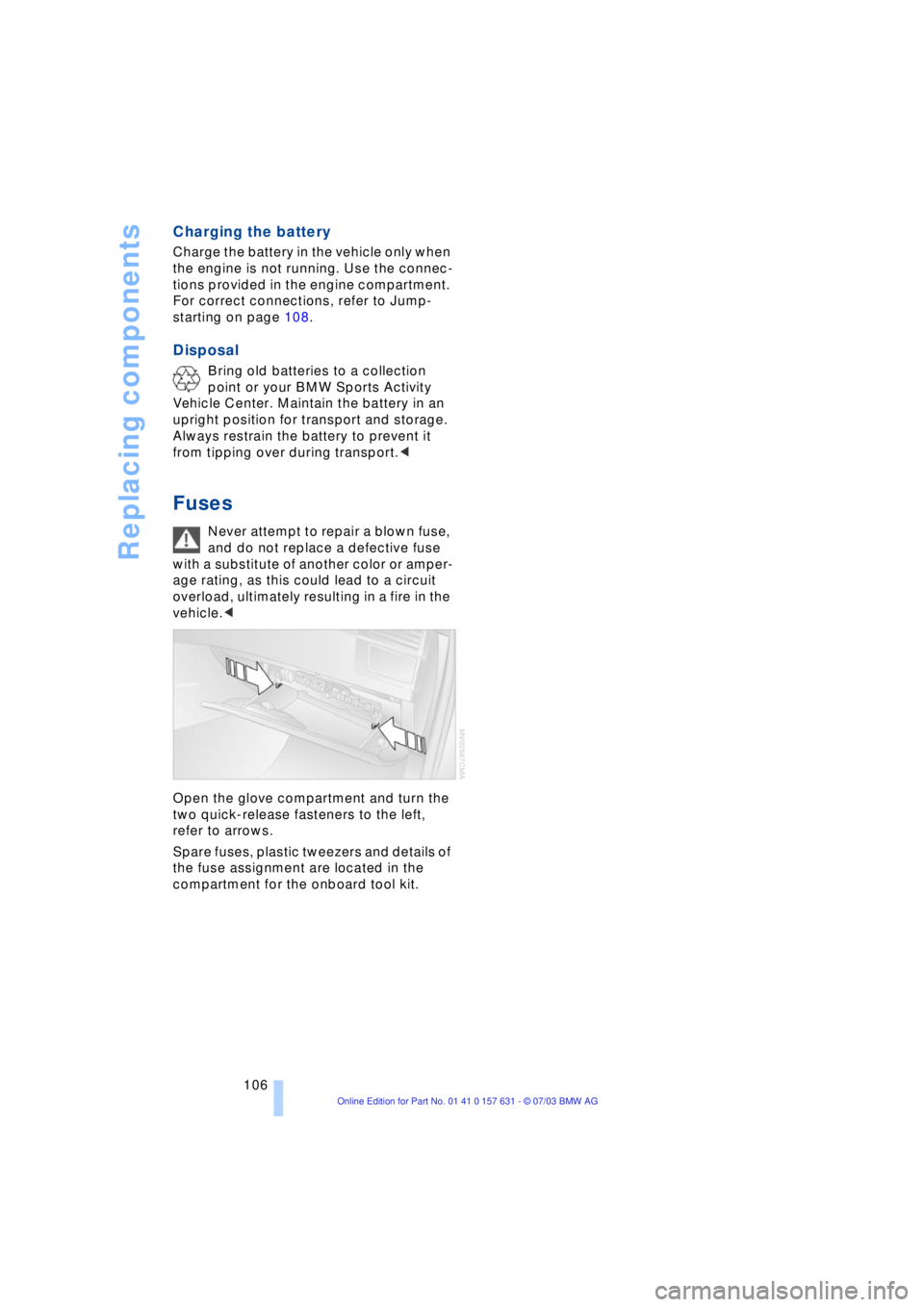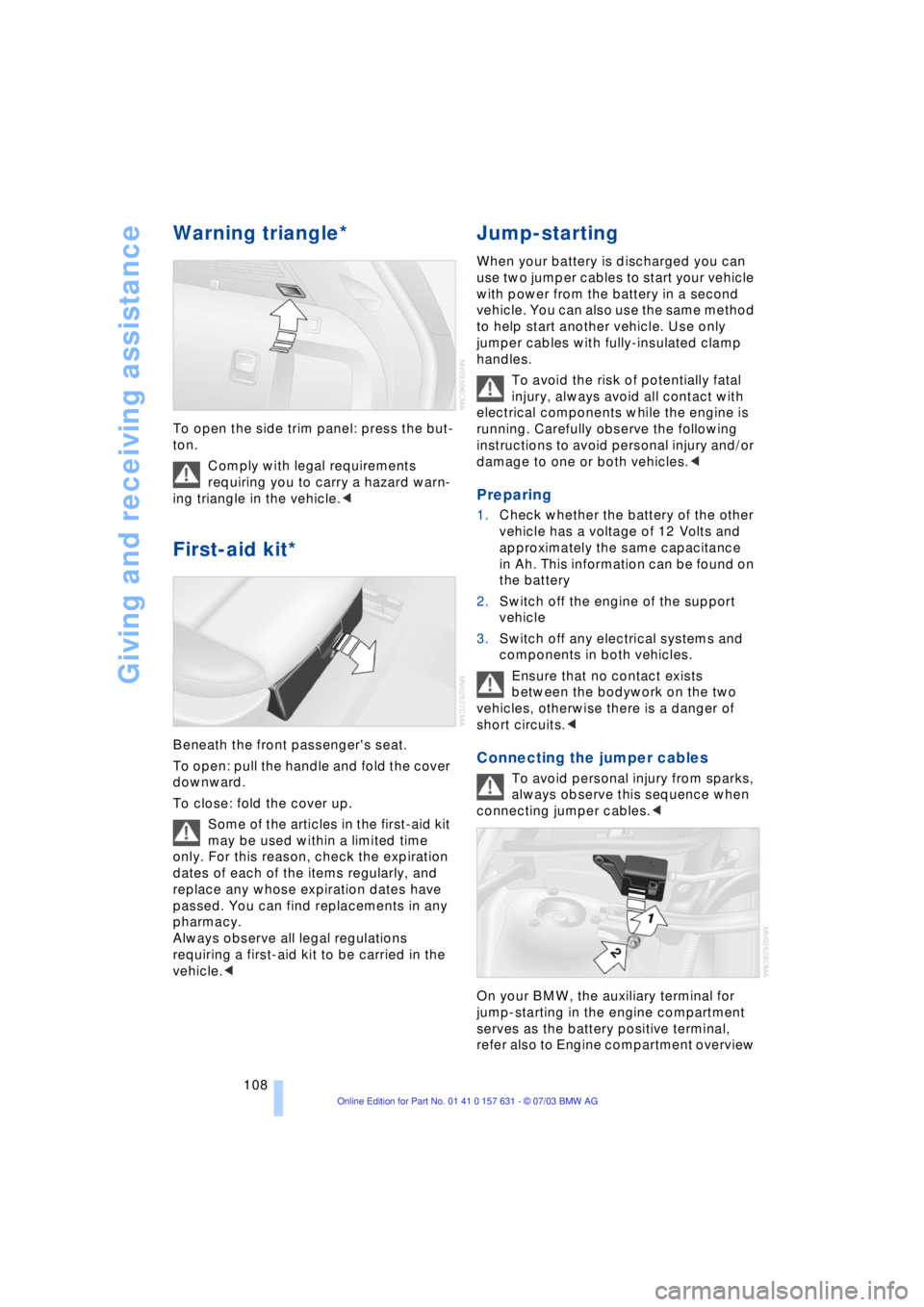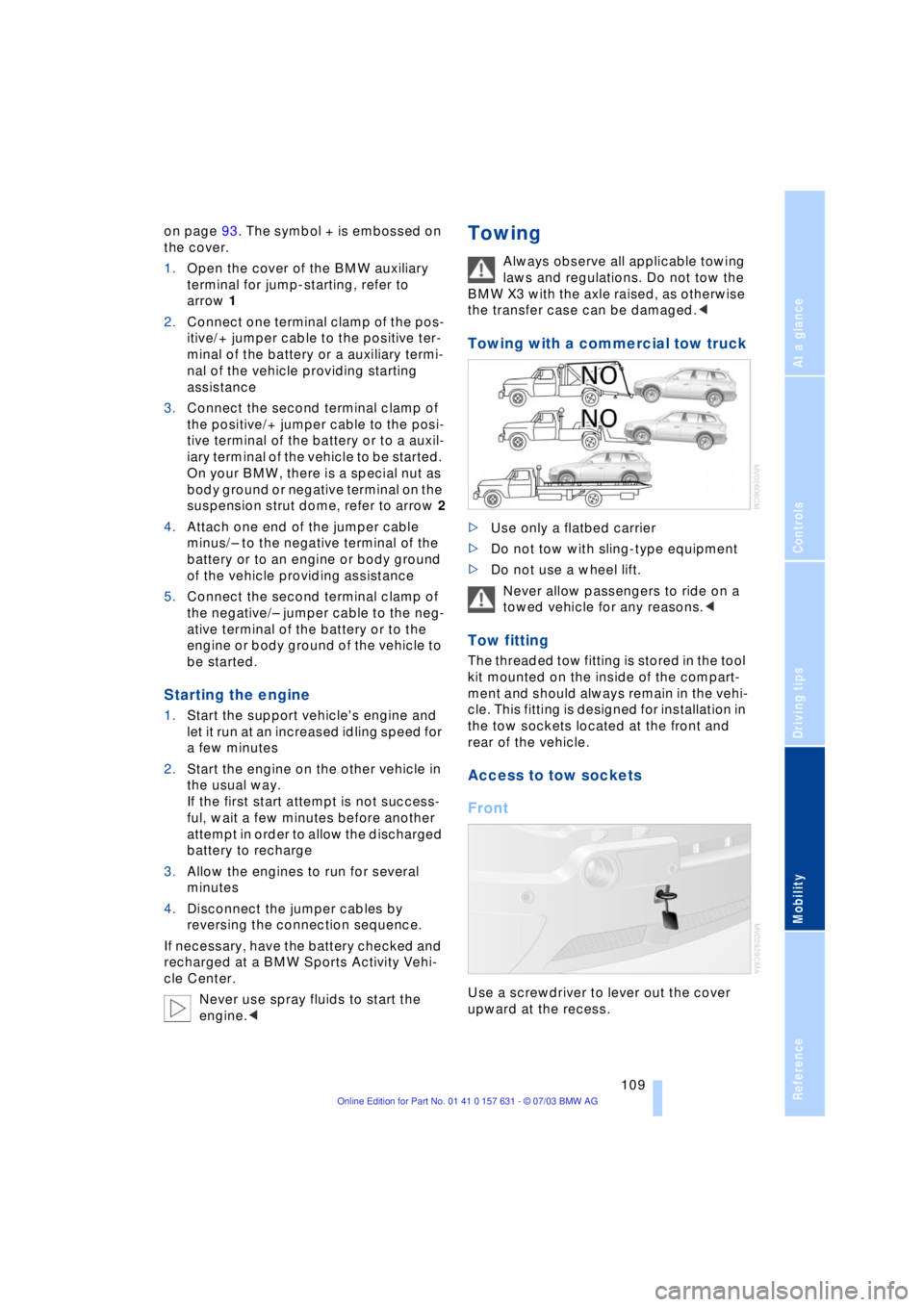2004 BMW X3 2.5I SAV battery
[x] Cancel search: batteryPage 101 of 132

Reference
At a glance
Controls
Driving tips
Mobility
99
Replacing components
Onboard tool kit
The onboard tool kit is located in a com-
partment on the left under the cargo area.
Replacing wiper blades
Front
1.Move the wiper to a fold-out position,
refer to page 42
2.Lift the wiper arm and press the secur-
ing spring, refer to arrow
3.Pull the wiper blade off toward the
wiper arm
4.Insert the new blade and snap it into
place.
Fold the wipers back down onto the
windshield before you turn the igni-
tion key to position 1 or 2 again. If you do
not, they could be damaged.<
Rear
1.Lift the wiper arm
2.Pull off the wiper blade, refer to arrow
3.Insert a new wiper blade.
Lamps and bulbs
The lamps and bulbs make essential contri-
butions to the safety of your vehicle. There-
fore, comply fully with the following instruc-
tions during bulb replacement. If you are
not familiar with the specified procedures,
BMW recommends having the replace-
ments carried out at your BMW Sports
Activity Vehicle Center.
Never touch the glass of new bulbs
with your bare fingers, as even minute
amounts of contamination will burn into the
bulb's surface and reduce its service life.
To install, use a clean cloth, napkin etc. or
hold the bulb by its metal socket.<
A replacement bulb set is available from
your BMW Sports Activity Vehicle Center.
To prevent short circuits, before
working on any electrical system,
equipment or accessory you should always
switch it off and disconnect the cable from
the battery's negative terminal before start-
ing.
To avoid possible injury or equipment dam-
age when changing bulbs, observe any
instructions provided by the bulb manufac-
turer.<
Page 107 of 132

Reference
At a glance
Controls
Driving tips
Mobility
105
Mounting compact wheel
1.Unscrew the lug bolts and remove the
wheel
2.Remove accumulations of mud or dirt
from the mounting surfaces of the
wheel and hub. Clean the lug bolts
3.Position the new wheel or compact
wheel. Secure the wheel by turning at
least two lug bolts into opposite bolt
holes
4.Screw in the remaining lug bolts.
Tighten all the bolts securely in a diag-
onal pattern
5.Lower the jack and remove it from
beneath the vehicle
6.Tighten the lug bolts in a diagonal pat-
tern
7.Check and correct the tire inflation
pressure at the earliest opportunity.
Protect valve stems and valve stem
seal caps against dirt and contamina-
tion. Dirt in valve stems is a frequent source
of gradual air loss.<
After mounting the compact wheel or cor-
recting the inflation pressure, reinitialize
the Flat Tire Monitor, refer to page 53.
The vehicle jack is designed for
changing wheels only. Do not attempt
to raise another vehicle model with it or to
raise any load of any kind. To do so could
cause accidents and personal injury.
To ensure safety, always have the lug bolts
checked with a calibrated torque wrench to
ensure that they are tightened to the spec-
ified torque of 101 lb ft/140 Nm as soon as
possible.<
Stow the defective wheel in the luggage
compartment.
When you mount wheels other than Genu-
ine BMW light-alloy wheels, different lug
bolts may also be required.
Replace the defective tire as soon as pos-
sible and have the new wheel/tire bal-
anced.
Driving with the compact wheel
Drive reservedly and do not exceed a
speed of 50 mph/80 km/h. Do not
deactivate DSC, as otherwise unstable
driving conditions may result.<
The driving characteristics change, for
example reduced track stability on braking,
extended braking distance, and altered
self-steering characteristics in the limit
range. In conjunction with winter tires,
these characteristics are more pro-
nounced.
Only one compact wheel may be
mounted. You should re-equipping to
wheels and tires of the original size as
quickly as possible.<
Battery
Battery care
The battery is 100% maintenance-free, i.e.,
the electrolyte will last for the life of the bat-
tery when the vehicle is operated in a tem-
perate climate.
Please contact your BMW Sports
Activity Vehicle Center with any ques-
tions concerning the battery.<
Do not disconnect the battery when
the engine is running. If you do so, the
ensuing voltage surge will damage the
vehicle's onboard electronics.<
Indicator lamp
The battery charge-current indica-
tor lamp lights up:
The battery is no longer being
charged. There is a defect on the alternator
V-belt or charge current circuit of the alter-
nator. Contact the nearest BMW Sports
Activity Vehicle Center.
Do not continue driving if the V-belt is
defective. The engine could be dam-
aged due to overheating.
Moreover, an increased amount of force is
required for steering if the onboard supply
voltage falls dramatically.<
Page 108 of 132

Replacing components
106
Charging the battery
Charge the battery in the vehicle only when
the engine is not running. Use the connec-
tions provided in the engine compartment.
For correct connections, refer to Jump-
starting on page 108.
Disposal
Bring old batteries to a collection
point or your BMW Sports Activity
Vehicle Center. Maintain the battery in an
upright position for transport and storage.
Always restrain the battery to prevent it
from tipping over during transport.<
Fuses
Never attempt to repair a blown fuse,
and do not replace a defective fuse
with a substitute of another color or amper-
age rating, as this could lead to a circuit
overload, ultimately resulting in a fire in the
vehicle.<
Open the glove compartment and turn the
two quick-release fasteners to the left,
refer to arrows.
Spare fuses, plastic tweezers and details of
the fuse assignment are located in the
compartment for the onboard tool kit.
Page 110 of 132

Giving and receiving assistance
108
Warning triangle*
To open the side trim panel: press the but-
ton.
Comply with legal requirements
requiring you to carry a hazard warn-
ing triangle in the vehicle.<
First-aid kit*
Beneath the front passenger's seat.
To open: pull the handle and fold the cover
downward.
To close: fold the cover up.
Some of the articles in the first-aid kit
may be used within a limited time
only. For this reason, check the expiration
dates of each of the items regularly, and
replace any whose expiration dates have
passed. You can find replacements in any
pharmacy.
Always observe all legal regulations
requiring a first-aid kit to be carried in the
vehicle.<
Jump-starting
When your battery is discharged you can
use two jumper cables to start your vehicle
with power from the battery in a second
vehicle. You can also use the same method
to help start another vehicle. Use only
jumper cables with fully-insulated clamp
handles.
To avoid the risk of potentially fatal
injury, always avoid all contact with
electrical components while the engine is
running. Carefully observe the following
instructions to avoid personal injury and/or
damage to one or both vehicles.<
Preparing
1.Check whether the battery of the other
vehicle has a voltage of 12 Volts and
approximately the same capacitance
in Ah. This information can be found on
the battery
2.Switch off the engine of the support
vehicle
3.Switch off any electrical systems and
components in both vehicles.
Ensure that no contact exists
between the bodywork on the two
vehicles, otherwise there is a danger of
short circuits.<
Connecting the jumper cables
To avoid personal injury from sparks,
always observe this sequence when
connecting jumper cables.<
On your BMW, the auxiliary terminal for
jump-starting in the engine compartment
serves as the battery positive terminal,
refer also to Engine compartment overview
Page 111 of 132

Reference
At a glance
Controls
Driving tips
Mobility
109
on page 93. The symbol + is embossed on
the cover.
1.Open the cover of the BMW auxiliary
terminal for jump-starting, refer to
arrow 1
2.Connect one terminal clamp of the pos-
itive/+ jumper cable to the positive ter-
minal of the battery or a auxiliary termi-
nal of the vehicle providing starting
assistance
3.Connect the second terminal clamp of
the positive/+ jumper cable to the posi-
tive terminal of the battery or to a auxil-
iary terminal of the vehicle to be started.
On your BMW, there is a special nut as
body ground or negative terminal on the
suspension strut dome, refer to arrow 2
4.Attach one end of the jumper cable
minus/Ð to the negative terminal of the
battery or to an engine or body ground
of the vehicle providing assistance
5.Connect the second terminal clamp of
the negative/Ð jumper cable to the neg-
ative terminal of the battery or to the
engine or body ground of the vehicle to
be started.
Starting the engine
1.Start the support vehicle's engine and
let it run at an increased idling speed for
a few minutes
2.Start the engine on the other vehicle in
the usual way.
If the first start attempt is not success-
ful, wait a few minutes before another
attempt in order to allow the discharged
battery to recharge
3.Allow the engines to run for several
minutes
4.Disconnect the jumper cables by
reversing the connection sequence.
If necessary, have the battery checked and
recharged at a BMW Sports Activity Vehi-
cle Center.
Never use spray fluids to start the
engine.<
Towing
Always observe all applicable towing
laws and regulations. Do not tow the
BMW X3 with the axle raised, as otherwise
the transfer case can be damaged.<
Towing with a commercial tow truck
>Use only a flatbed carrier
>Do not tow with sling-type equipment
>Do not use a wheel lift.
Never allow passengers to ride on a
towed vehicle for any reasons.<
Tow fitting
The threaded tow fitting is stored in the tool
kit mounted on the inside of the compart-
ment and should always remain in the vehi-
cle. This fitting is designed for installation in
the tow sockets located at the front and
rear of the vehicle.
Access to tow sockets
Front
Use a screwdriver to lever out the cover
upward at the recess.
Page 121 of 132

Reference
At a glance
Controls
Driving tips
Mobility
119
Everything from A to Z
Index
A
A/C operation
Ð air conditioner 60
Ð automatic climate
control 63
ABS Antilock Brake
System 50
Ð indicator lamp 50
Accessories 6
Activated-charcoal filter 65
Adaptive Head Light 57
Adding engine oil 95
Adjusting seats 27
Ð electric 29
Ð mechanical 28
Air, drying, refer to A/C
operation 61, 64
Airbags 54
Ð deactivating 34
Ð indicator lamp 55
Ð sitting safely 27
Air circulation, refer to
Recirculated-air
mode 61, 64
Air conditioner 60, 63
Air distribution
Ð air conditioner 61
Ð automatic climate
control 64
Airing, refer to
Ventilation 61, 65
Air outlets, refer to
Ventilation 61, 65
Air pressure, refer to Tire
inflation pressure 86
Air supply
Ð air conditioner 61
Ð automatic climate
control 64
Air vents, refer to
Ventilation 61, 65
AKI, refer to Fuel
specifications 85Alarm system 24
Ð avoiding unintentional
alarms 25
Anchorages 73
Antifreeze
Ð coolant 95
Ð washer fluid 94
Antifreeze protection
Ð coolant 95
Anti-theft alarm system 18
Ð refer to Alarm system 24
Anti-trapping mechanism
Ð panorama glass roof 24
Ð power windows 22
Approved engine oils 95
Approved gross vehicle
weight 116
Armrest 68
Ð front 68
Ð rear 68
Artificial leather, refer to
Caring for your vehicle
brochure
Ashtray 69
Ð front 69
Ð rear 69
AUC Automatic
recirculated-air
control 64
Automatic
Ð air distribution 64
Ð air supply 64
Automatic car wash, refer
to Caring for your vehicle
brochure
Automatic climate
control 63
Automatic cruise control 43
Automatic curb monitor 32
Automatic headlamp
control 57
Automatic program, refer to
automatic air-
distribution 64Automatic rear window
cleaning 43
Automatic recirculated-air
control AUC 64
Automatic transmission
Ð malfunction 41
Automatic transmission
with Steptronic 39
Ð indicator lamp 41
Ð interlock 37
Ð selector lever interlock 40
Ð shiftlock 40
Average fuel
consumption 48
Average speed 48
Avoiding unintentional
alarms 25
Axle load, permitted 116
B
Backrests, refer to
Adjusting seats 28
Backup lamps 39
Ð replacing bulbs 102
Bad roads 80
Bar, towing 109
Batteries, disposal 106
Battery 105
Ð indicator lamp 12, 105
Ð jump-starting 108
Belts, refer to Safety
belts 30
Beverage holders 67
Black ice, refer to Ice
warning 47
Blower
Ð air conditioner 61
Ð automatic climate
control 64
BMW maintenance
system 97
BMW sports seat 28
Bore, refer to Engine
data 114
Page 129 of 132

Reference
At a glance
Controls
Driving tips
Mobility
127
Units 47
Ð outside temperature 47
Universal garage-door
opener, refer to
Integrated universal
remote control 66
Universal remote
control 66
Unlocking
Ð engine hood 92
Ð from inside 21
Ð from outside 19
Upholstery care, refer to
Caring for your vehicle
brochure
V
Vacuum cleaner
connection 69
Vehicle
Ð battery 105
Ð dimensions 115
Ð loading 78
Vehicle battery 105
Vehicle jack 103
Vehicle Memory 33
Ventilation 61, 65
Ð draft-free 61, 65
Voice control, refer to
separate Owner's Manual
W
Warning and indicator
lamps 12
Warning triangle 108
Warranty, refer to Service
and Warranty Information
Booklet for US models,
Warranty and Service
Guide Booklet for
Canadian models 97
Warranty and service
notes 7
Washer fluid 94
Washer fluid reservoir, refer
to Windshield/headlamp
washer system 94
Weights 116Wheel/tire combination,
refer to Replacing
wheels/tires 89
Wheelbase, refer to
Dimensions 115
Wheel bolts
Ð wrench 103
Wheel changes
Ð compact wheel 103
Wheels and tires 90
Width, refer to
Dimensions 115
Windows 22
Ð convenience operation 20
Window wipers
Ð replacing 99
Windshield
Ð cleaning 42
Windshield washer
Ð washer fluid 94
Windshield washer system
Ð washer/wiper system 41
Windshield wiper blade
replacement 99
Windshield wipers, refer to
Wiper/washer system 41
Winter tires
Ð changing 103
Ð condition 89
Ð storage 90
Wiper/washer reservoir 94
Wiper blade
replacement 99
Wiper system 94
Working in the engine
compartment 92
Wrenches, refer to
Onboard tool kit 99
X
xDrive 51
Xenon lamps 101
Ð replacing the bulbs 101